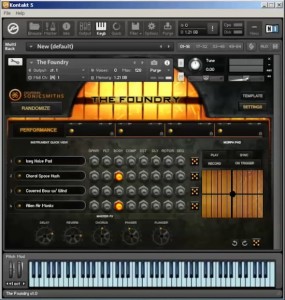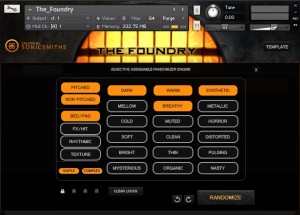Software Review: The Foundry by Sonicsmiths
In the world of virtual instruments, it’s safe to say that the number of choices out there has become overwhelming, especially once you realize just how deep and malleable each of the many choices are.
From gargantuan sample libraries to virtual synthesis engines with infinitely configurable controls, it can be hard to make quick decisions and get down to the business of writing music with so many features under the hood begging to be tweaked and explored.
Of course, there are always plenty of presets, but using those often leads to some guilty feelings, especially when you hear the same sound somewhere else. However, in my experience writing for television, where decisions need to be made quickly and minutes really make a difference, the use of presets often becomes a necessary evil—especially when introducing new elements to a score that aren’t a regular part of the sonic toolkit.
When I first heard about The Foundry by Sonicsmiths, I was intrigued because it’s a system which doesn’t really use presets, and is instead designed to create unique sounds that can be accessed quickly and tailored deeply when necessary.
Description
The Foundry is a sample-based instrument that runs on Native Instrument’s Kontakt engine. What sets it apart from it’s contemporaries is what Sonicsmiths call their “Adjective Assignable Randomizer Engine”, or AARE.
The AARE allows quick and random generation of sounds through use of actual adjectives.So, when you are asked for that “mysterious, creepy, but also warm” sound, you can easily generate a jumping-off point which you can be sure isn’t a standard and overused preset.
The basis of each sound is based on a blend of four different samples, selected by the randomization engine. It doesn’t stop there of course. Once you’ve found a combination that gets you something you can work with there are an abundance of options including:
• 3 mode Step Sequencer.
• 4-way Morphing Engine – This allows easy morphing transitions between sounds via the use of the XY pad built into the interface, or via MIDI velocity, pitch, or CC messages.
• Body Designer: With over sixty different body types, you can manipulate each of the “core” sounds by sending them through different material types, such as tubes, bricks, glass, dog bodies etc.
• 6 modulators assignable to Filters, Pitch, Amplitude, and Surround Panning allow for a wide range of stuttering, pulsing, frequency modulation, and many standard synthesis techniques.
• Graining Synthesis: You can take most of the patches in the library and add the granular synthesis effect, with stretching, panning, and many other ways of manipulating the sound.
• Surround Mode: Set all four sounds to go out different channels, as well as pan in surround.
• Unique reverb selections: including Swaps, Churches, Studios, etc.
• Fully adjustable Filters, Distortion, Compressors, Delays, Panning Rotators, Surround Routing Abilities, and many more creative tools.
The Foundry uses around 19 Gb of samples (compressed into around 13Gb), so the while the possibilities aren’t exactly infinite, the chances of randomly generating the same sound twice is highly improbable.
In Use
While the Foundry is undeniably a deep and configurable instrument, its ability to randomly create interesting and unique sounds quickly is its chief selling point.
Almost immediately after installing it I found a use for it generating some “scary” pads for a project I’m working on. It really is as simple as navigating to the AARE page and selecting a few of the adjectives that describe what you’re looking for. If you don’t like what you hear, all you need to do is click the Randomize button again and something new will be loaded.
This process always got me into the ballpark, and from there it became about performing a few tweaks. For me, this meant adjusting the blend of the four basic samples, and perhaps adding some different effects or modulations to the sample components. In my experience, the Foundry seems to excel most when relegated to expansive pads and sound design.
Another cool feature of this instrument is that the randomization engine can also be applied to both the individual processing of each sample, and to the step sequencer.
Any parameter that can be randomized has a button with a six-sided die icon. There is a real potential to surprise yourself with new and interesting textures, and it’s heartening to know that they will always be unique.
In Summary
The depth and complexity of sound the Foundry is able to quickly generate makes it a no-brainer for in-a-pinch arranging. At $299.95, it might require a moment’s consideration, but there is some comfort in knowing that the sounds you’ll be able to get out of it will always be different and unique and, when necessary, very configurable.
Since I added Foundry to my Kontakt libraries, I’ve used it more than I anticipated I would, and often for reasons as simple as receiving a brief from clients that used adjectives similar to those found in the Foundry’s AARE engine. This seemed a bit silly at first, but when I was actually able to get quick and successful results, I was hooked.
For more information about the Foundry check out this walkthrough of the features at SonicSmiths.com
Please note: When you buy products through links on this page, we may earn an affiliate commission.








